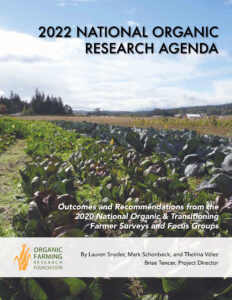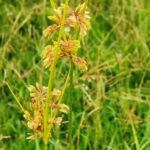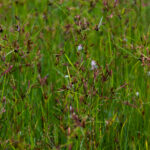 The Organic Farming Research Foundation 2022 National Organic Research Agenda (NORA) is a report informed by surveys and focus groups conducted in 2020 with over 1,100 certified organic farmers and ranchers across North America.
The Organic Farming Research Foundation 2022 National Organic Research Agenda (NORA) is a report informed by surveys and focus groups conducted in 2020 with over 1,100 certified organic farmers and ranchers across North America.
What Farmers Said
- In the NORA report, two-thirds of survey respondents (67%) cited weed management as a substantial production challenge.
- Specific feedback from organic farmers also underscores the need for additional research on controlling weeds such as nutsedge.
Knowing Your Weeds
Farmers and researchers alike acknowledge that weeds pose the greatest barrier to building healthy soils in organic cropping systems. Management of weeds in an organic cropping system involves integration of many separate management tactics. Which tactics you use will depend on the weed species present, the crop, the time of year the crop is planted, the type of equipment you have available, other crops in the rotation, and other site and operation-specific factors.

 Managing Nutsedge
Managing Nutsedge
Nutsedge is a highly competitive and persistent weed in a wide range of crops and extreme measures are often taken to manage it. In conventional and organic systems alike, the most common method for controlling yellow and purple nutsedge is to desiccate the tubers by timely, repeated tilling. Farmers working toward sustainable conservation tillage systems may first need to take steps to control a current infestation of weeds before returning to reduced tillage practices.
To reduce the impact of nutsedges on production, farmers can:
- Mechanically control weeds by repeated cultivation every 2-3 weeks
- Cultivate an infested area and then withhold all moisture to allow the sun to dry tubers (note: this drying approach only works on purple nutsedge, not yellow nutsedge)
- Implement shading techniques
- Consider crop rotations and cover cropping
- Cautiously consider solarization or occultation
- Implement rotational grazing
Once control of nutsedge is achieved, efforts should return to restoring soil health. The following steps are key to soil health:
- Keep the soil covered
- Maximize living roots in thesis profile
- Minimize soil disturbance
- Energize the system with biodiversity
For more on weed management and applicable solutions that control this common weed, farmers can download OFRF’s Weed Management Guide and Weed Profile on Nutsedge.


